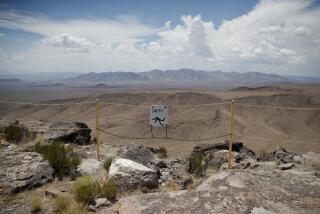Experts Dispute Nuclear Dump Data
- Share via
LAS VEGAS — A team of researchers agreed that hot water existed in Yucca Mountain rock more than 4 million years ago, but they can’t agree whether the finding means nuclear waste shouldn’t be buried there.
A Russian scientist representing Nevada in the $1.4-million study sided with a Nevada state geological consultant Thursday in arguing that nuclear material should not be stored in the mountain, 90 miles northwest of Las Vegas.
“My personal opinion is you can take the data . . . and come to the conclusion this cannot have resulted without having [thermal] water flowing inside,” Yuri Dublyansky of the Russian Academy of Sciences, Siberian Branch, said during a briefing.
Dublyansky said that if thermal ground water shot upward in the mountain in the past, it could happen again, creating a threat to flood the cavern and spread radioactivity from nuclear waste stored in the mountain.
But a U.S. Geological Survey geochemist attributed the water evidence in rock samples to rainwater seepage. Current rainfall totals are low enough that they aren’t seen as a threat by most experts.
Jean Cline, the University of Nevada-Las Vegas associate professor who headed a two-year study, said the study found no evidence of hot water in Yucca Mountain in the past 2 million years.
“I don’t think Yucca Mountain was a hydrothermal system,” Cline said.
Dublyansky and Nevada state geological consultant Jerry Szymanski said the evidence of water in ancient rock means the site should be disqualified for nuclear waste disposal.
“It is my personal opinion Yucca Mountain cannot be licensed as a permanent repository,” Szymanski said.
Yucca Mountain is the only site being studied to entomb 77,000 tons of the nation’s high-level nuclear waste, mostly metal rods containing spent fuel pellets from commercial power reactors.
Nevada, Clark County and Las Vegas are contributing money to buy advertising to help stir opposition and press the Department of Energy to reject the site.
At the urging of U.S. Sen. Harry Reid, D-Nev., the federal inspector general’s office is investigating allegations of bias in the site selection process by the Department of Energy and its contractors.
Scientists agree the volcanic rock ridge was formed by hot ash that spewed from volcanic eruptions nearly 13 million years ago. Roughly 11 million years ago, the mountain was reheated by below-ground volcanic activity from nearby Timber Mountain.
Based on fluids trapped in Yucca Mountain’s calcite, the majority of the study team, including geochemist Joseph Whelan of the U.S. Geological Survey office in Denver, thinks the minerals took 6 million years to cool to temperatures ranging from 113 degrees to 140 degrees Fahrenheit.
The scientists analyzed 155 mineral samples, finding that about half, 78, contained “fluid inclusion” records indicating elevated temperatures.
Whelan insisted that the minerals were formed by rainwater that percolated from Yucca Mountain’s surface.
Szymanski and Dublyansky held to their claim that the minerals were formed by hot water from within and that the mountain did not take 6 million years to cool.
“Something had to cause those elevated temperatures,” Cline said “but our study didn’t address that.”






